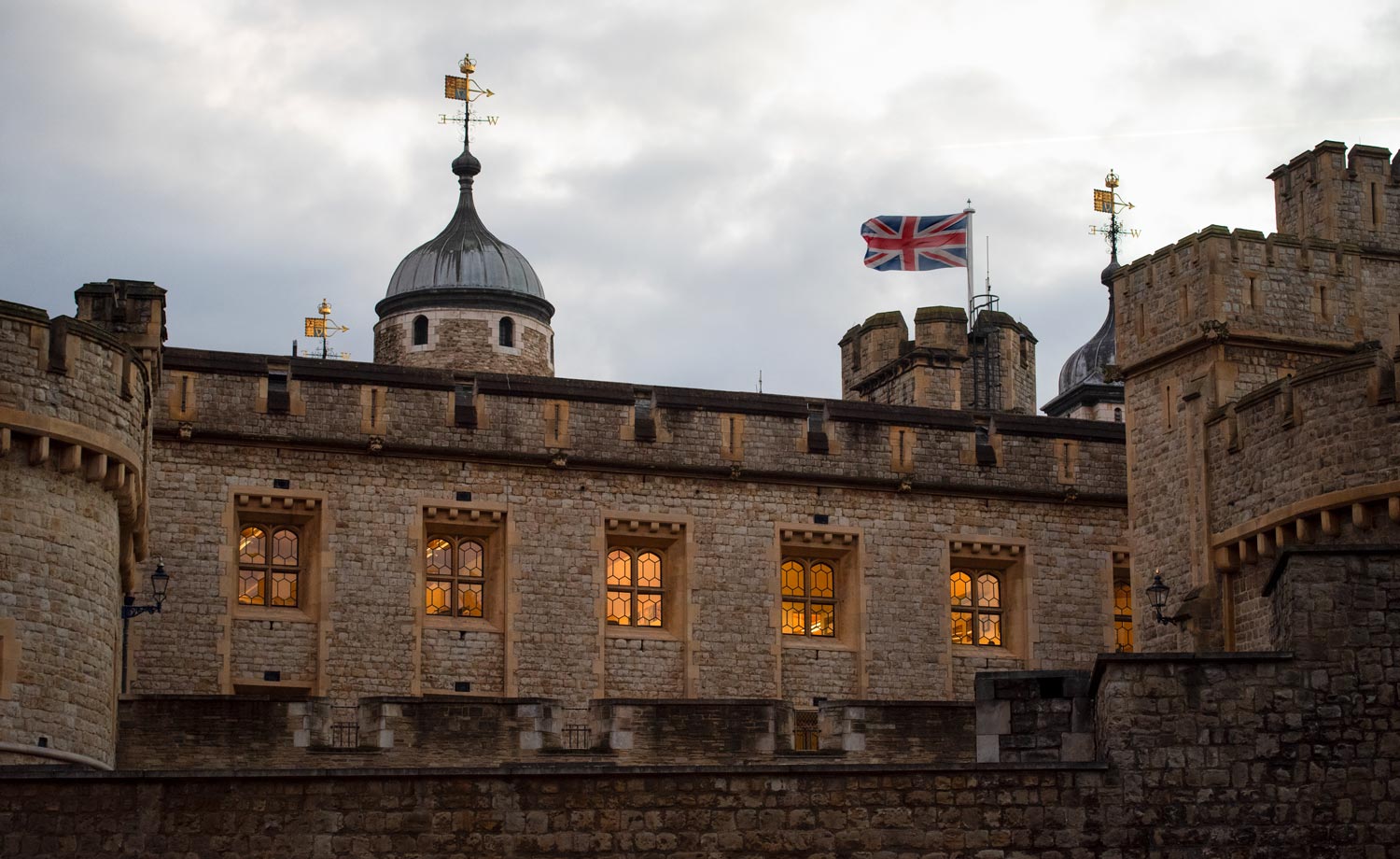The Tower of London
Photos by Forrest Anderson
Fortress, palace, prison, treasure house – the Tower of London for a millennium played a crucial role in shoring up the British monarchy and ruling elite. The Tower along with Windsor Castle has created the iconic storybook picture of a castle with round crenelated corner towers, spiked iron gates that can be raised and lowered, a cruel torture chamber and flags flying.
The White Tower at the heart of the castle that is the Tower of London is one of the largest castle keeps in the Christian world and the most complete eleventh-century palace in Europe.
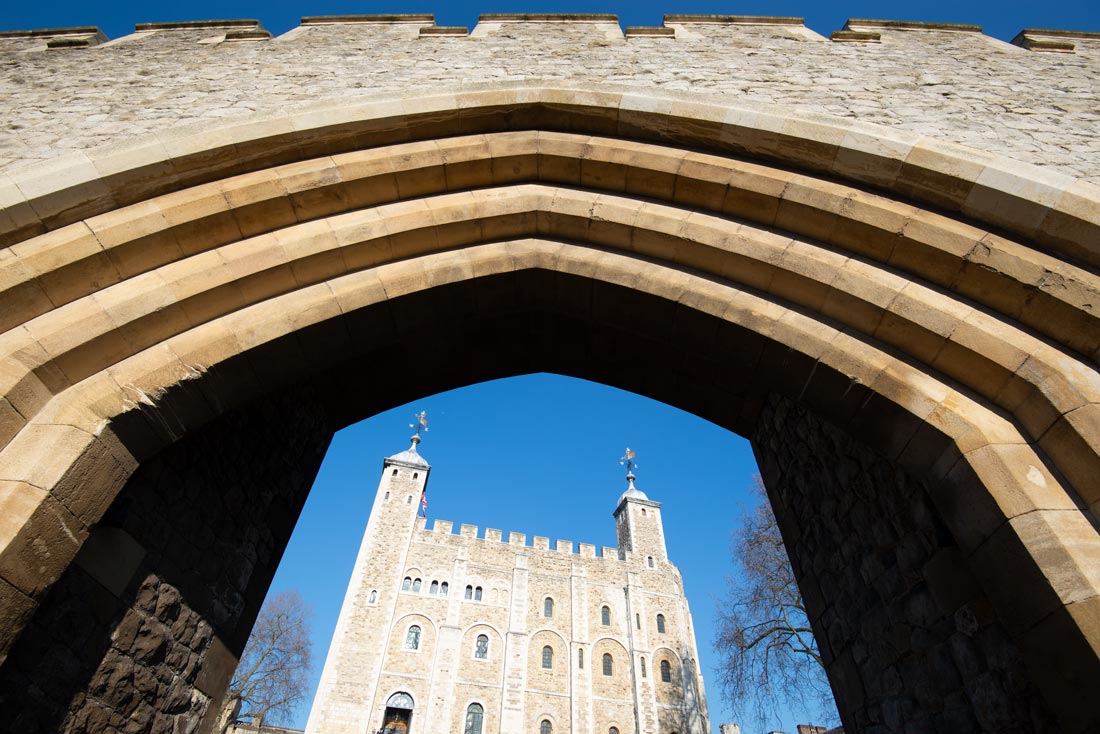
The White Tower through an arched gate in the castle wall. The White Tower is the larger castle's keep.
In the beginning, however, it looked nothing like that. The castle’s story began with a dynastic crisis when Edward the Confessor, the king of England, died childless in 1066. Several relatives vied for the throne and Harold Godwinson, Edward’s brother-in-law, was crowned. However, a distant blood relative, William, Duke of Normandy, claimed that he had been promised the throne. William invaded England and defeated Harold’s forces at the Battle of Hastings. He then lay waste to the countryside leading to London. The city’s leaders prudently submitted to his forces. In preparation for his entrance into London, William sent an advance guard to build a castle. They conscripted the labor from nearby shires.
William was crowned in Westminster Abbey, the traditional site of English monarchs’ coronations, on Christmas Day 1066. His new castle became crucial to his controlling the disgruntled population of London.
William’s castle was built on the river Thames to dominate river traffic coming into London and protect the city from a river attack. It was constructed using preexisting city walls built centuries earlier by the Romans and added onto in medieval times.
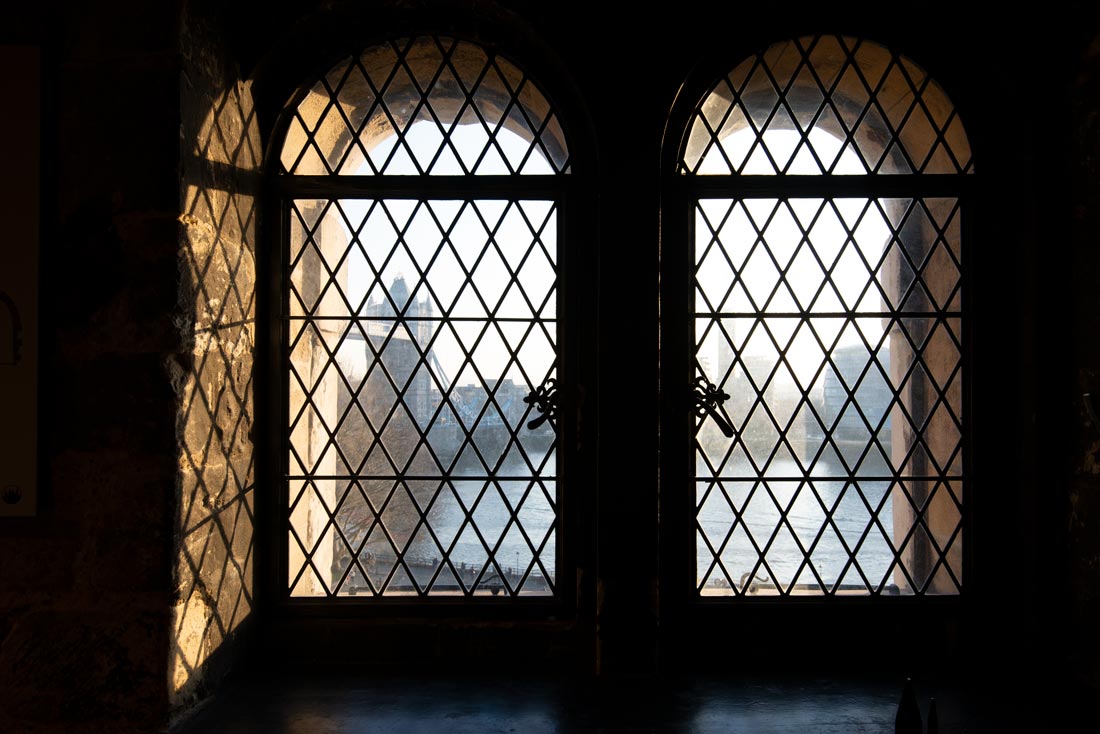
Only these two windows remain from the Norman castle. Others have been replaced. The nearby Thames and Tower Bridge can be seen through them.
Between 1066 and 1087, William established at least 36 castles and his subordinates founded more in the most extensive castle-building spree in feudal Europe. The castles were fortifications, administrative centers and residences.
William built the castle’s huge keep, which became known as the Great Tower. Most of London was low wooden buildings, and the tower dominated the city for miles. It was well protected by the Roman walls, ditches on the north and an earthwork with a wooden palisade atop it. In the 13th century, King Henry III ordered the tower whitewashed inside and out with white lime and it became known as the White Tower.
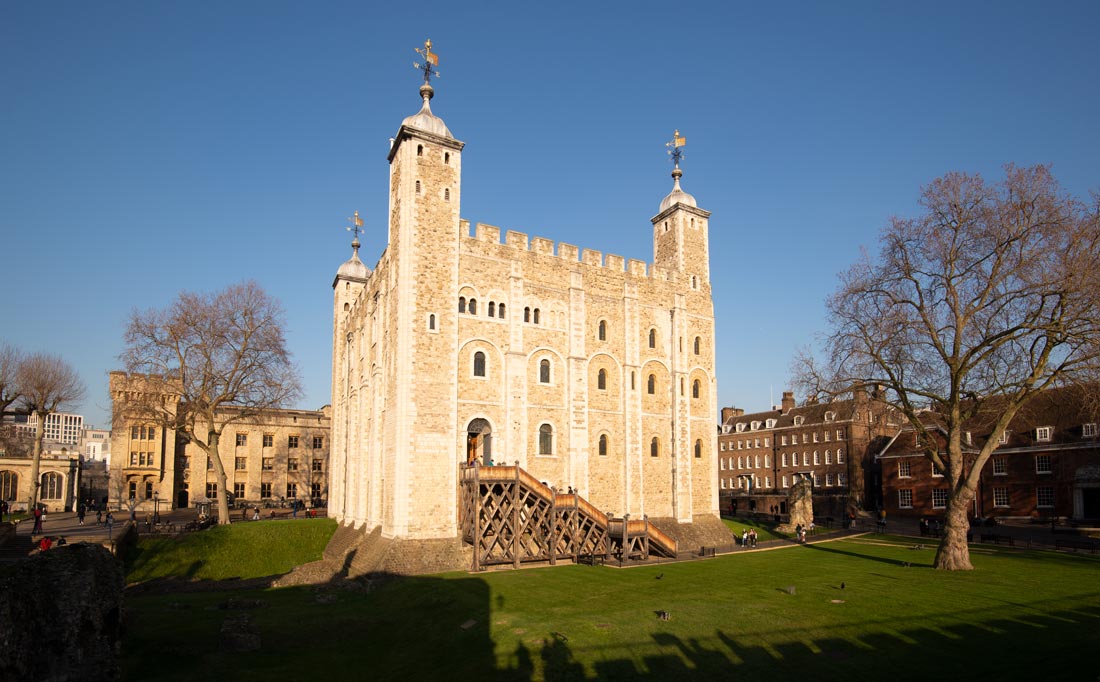
The White Tower in the center of Tower Green, the innermost part of the castle.
Subsequent kings kept building more fortifications, until by 1350 two concentric rings of stone walls surrounded the White Tower, which became the inner keep. The Tower of London is one of the most complete and well-preserved early medieval secular buildings in Europe.
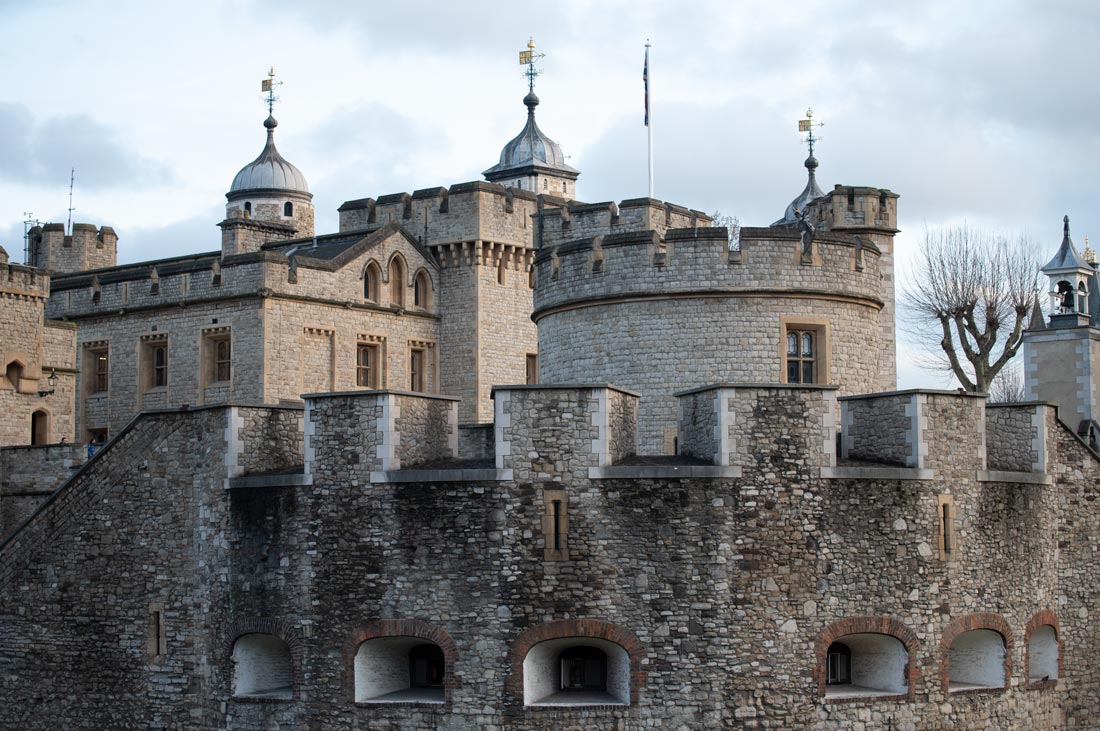
The White Tower is protected by two rings of walls, the layers of which can be seen in this photo and the one below.
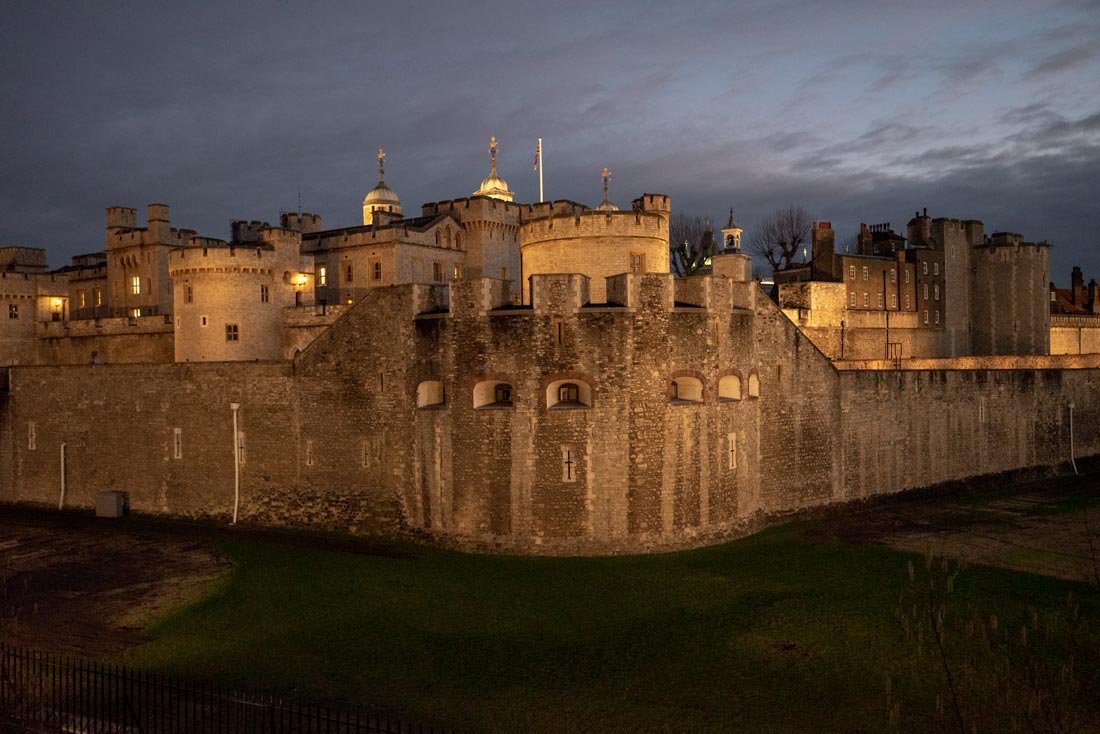
Under Richard I, the Lionhearted (1189-99), the tower complex doubled in size. Richard was off on a crusade when his brother John, the villain of English lore, besieged the tower. When the castle’s supplies ran out, it surrendered, but Richard regained it when he returned to London. John pleaded for forgiveness and became Richard’s successor.
John probably was the first to keep a menagerie of exotic animals at the castle, a tradition that continued until the 1830s. The menagerie began because medieval monarchs exchanged exotic animals as gifts. In 1235, Henry III was presented with three wild cats by the Holy Roman Emperor Frederick II. The cats probably were lions, a reference to the Plantagenet arms which are made up of three lions. Over the years, an elephant, a polar bear that fished in the Thames, an ostrich and other exotic animals were held at the castle.
John was forced to make important concessions to barons by issuing the Magna Carta which limited his power in 1215. However, John reneged on the document, and his opponents, who were controlling the Tower of London, invited Prince Louis of France to take the throne. Louis invaded France, but John died suddenly and his son Henry III became king at age 9. Louis’ forces were defeated. Henry and his mother lived in the castle and fortified it with more towers and a moat amid continuing threats from the restless barons.
Fortress
The barons’ and commoners' discontent forced early kings to seek refuge in the tower multiple times. In 1381, 10,000 peasants angry over a new tax revolted and burned and plundered the capital. King Richard II rode out of the castle to pacify them and left the gate open. At least 400 rebels stormed the castle and ran through it searching for officials whom they blamed for the tax increase. The men guarding the Tower put up no resistance, and the peasants shook hands with them in friendship. Several rebels asked the queen’s mother to kiss them. Princess Joan fainted as a result and her servants carried her to safety. The rebels found Archbishop of Canterbury Simon Sudbury, the king’s chancellor and tax collector, in the castle chapel where he had gone to pray. The peasants dragged him out to nearby Tower Hill, where he was beheaded. His mangled head was impaled on a spike and mounted over the gate of London Bridge. The peasants dispersed after the king agreed to their demands.
The king, however, later lost his crown to the next king, Henry IV, and returned to the tower as a prisoner. During the reign of Richard II (r1377-1399 CE), poet Geoffrey Chaucer (c.1343-1400) acted as the tower’s clerk of works.
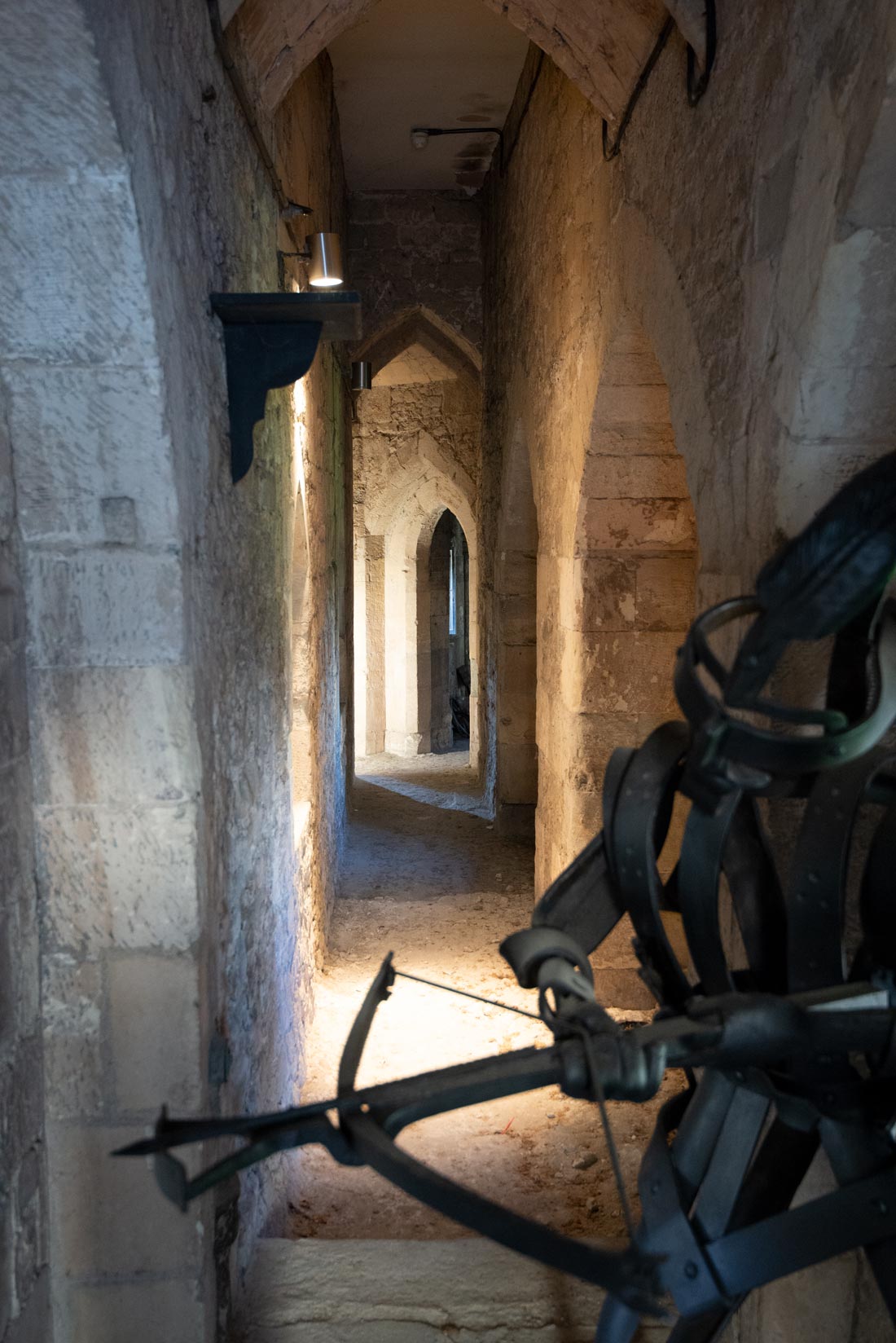
The inner part of one of the walls around the Tower of London, with a sculpture of a knight defending it.
The Tower was the headquarters for supplying England’s armed forces from 1066 to 1850, a role commemorated in a permanent exhibition of armor and arms in the White Tower called the Line of Kings. Among items displayed at the Tower are a massive suit of armor used by the portly Henry VIII and armor used by other kings. Thousands of weapons were made and stored at the Tower, which was a national arsenal. Leading scientists, mathematicians and craftsmen worked there on arms and the Tower was a showcase for technical design. The first royal telescope was placed on the White Tower in 1674-5 in an unsuccessful attempt to enable mariners to pinpoint their positions at sea using longitude, which was a key issue for naval warfare and trade.
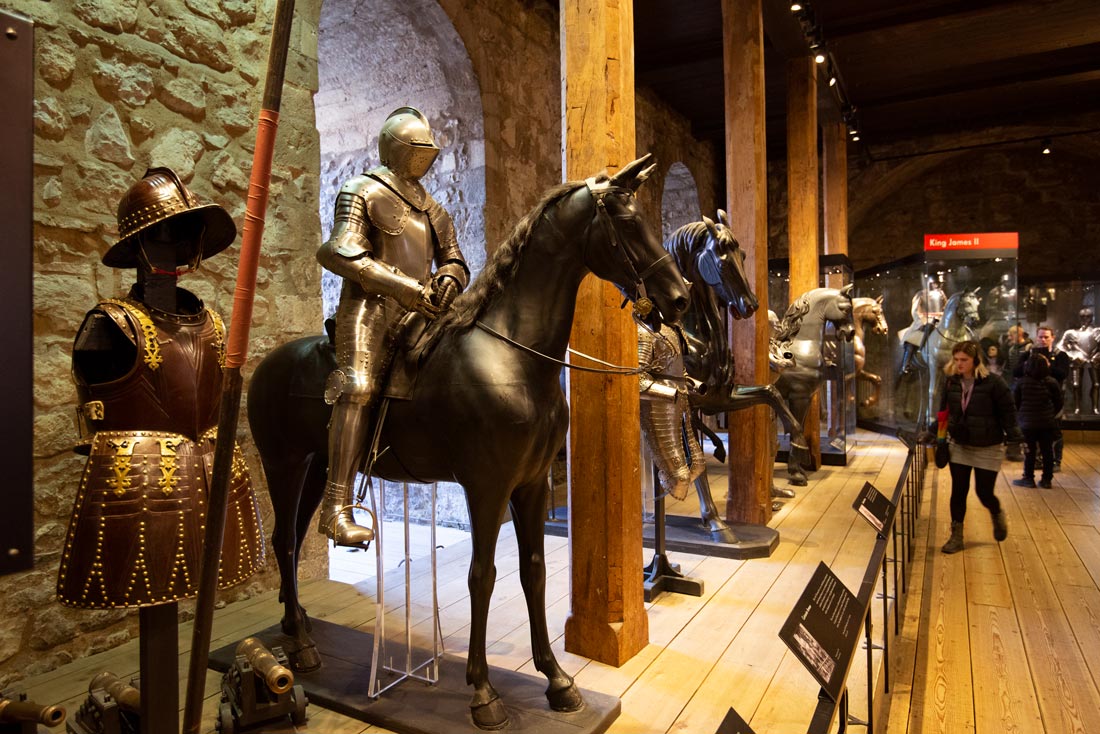
The Line of Kings exhibit in the White Tower includes armor worn by various kings of England over the past millennia as well as other valuable armor. Below, armor believed to have been used by Charles I.
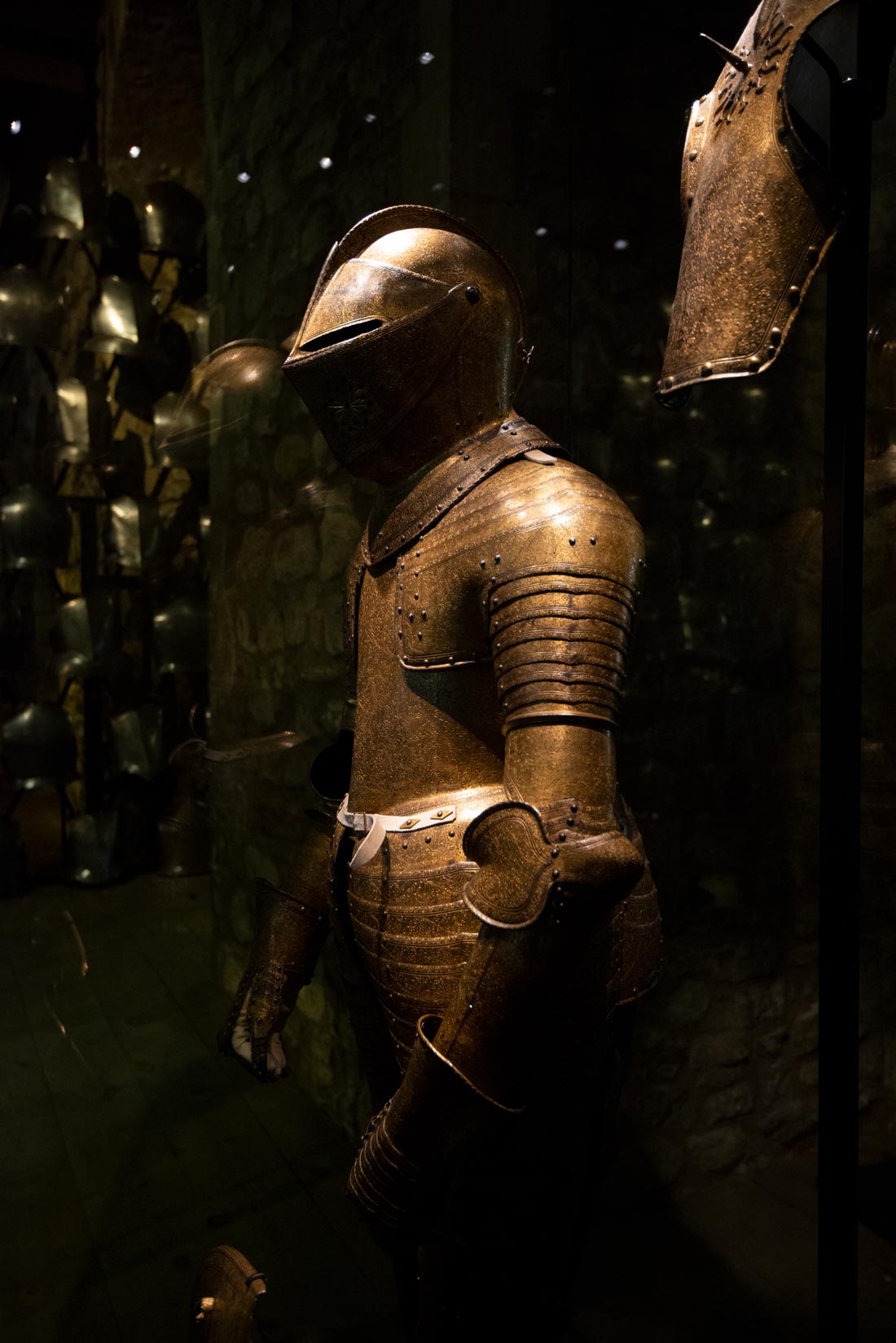
In addition to arms, the Tower kept stores for use in a siege and a deep well.
A curfew bell has rung from the castle’s Bell Tower for almost 500 years to signal the nightly closing of the Tower Gates. The current bell dates from 1651. The outer gates still are locked nightly in a Ceremony of the Keys in which the keys are delivered to the monarch’s representative, the castle’s resident governor. Part of the ceremony is the shouting of the words “Halt! Who goes there?”
The area around the Tower, including Tower Hill, is controlled by the Tower but the borders have been disputed with the City of London for centuries. It is marked as boundary stones and every three years on Ascension Day, local children and officials walk the streets around the Tower and beat the stones with willow wands. This tradition, called Beating the Bounds, dates back to a 14th-century legend that boys were beaten at the stones so that they would remember their location.
Every ship that went upstream to the city once had to moor at Tower Wharf to unload a portion of its cargo for the tower constables. Today, when a Royal Naval vessel moors on the wharf, its captain must present the tower constable with a barrel of wine, which is escorted into the tower by the castle’s Yeoman Warders and presented to the tower constable. The Yeoman Warders, once the monarch’s personal bodyguards, dress in Tudor costumes and guide tourists around the castle or perform other duties related to the tower’s status as a historic site.
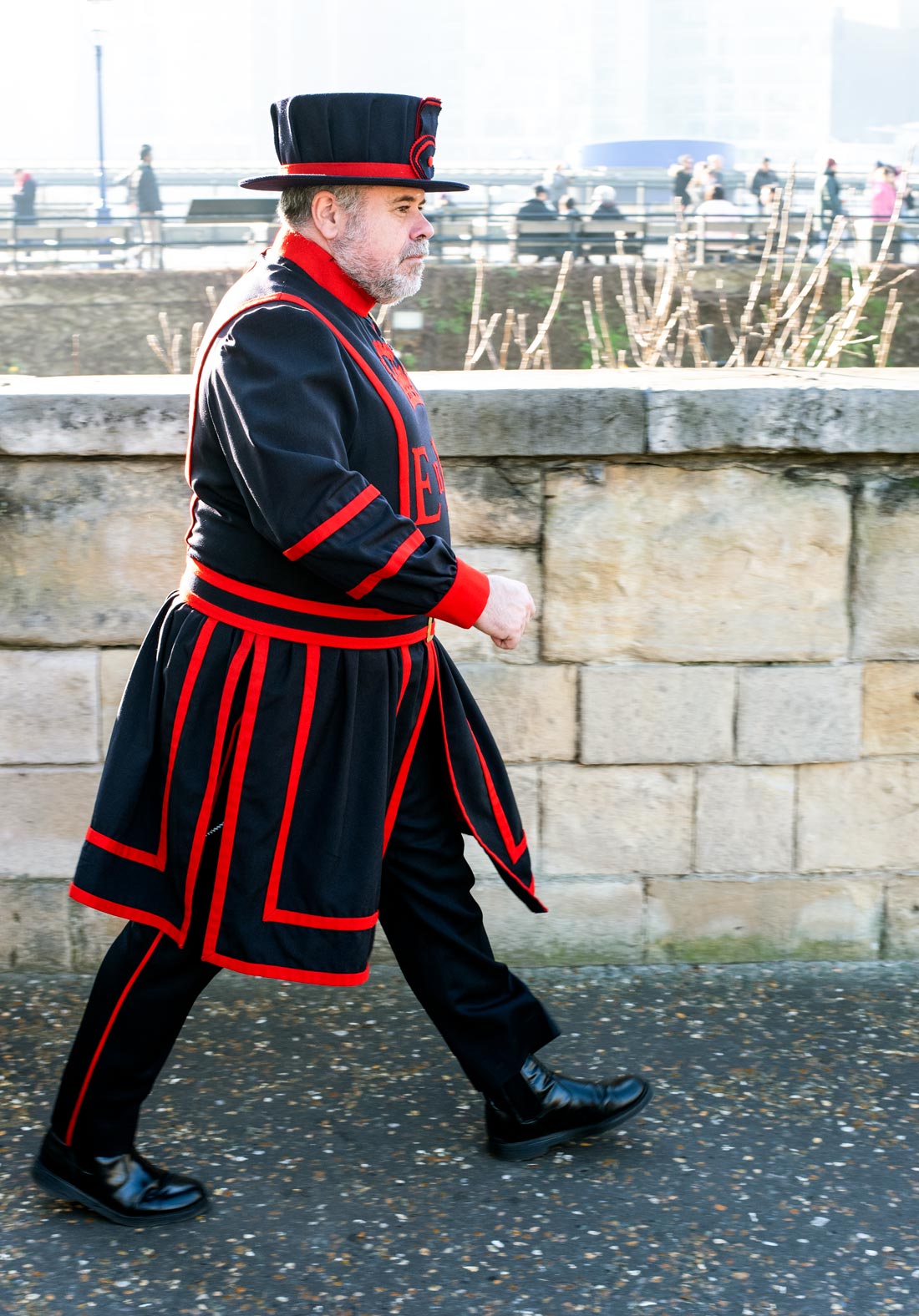
A Yeoman Warder at the Tower of London.
One of the first recorded royal salutes fired from the Tower of London was in 1533 to mark the coronation of Henry VIII's second wife, Anne Boleyn. Since then, gun salutes there have marked a variety of occasions. Sixty-two gun salutes are fired for the Queen’s birthday and the anniversary of her accession to the throne, and 41-gun salutes are fired at the State Opening of Parliament. Royal births are celebrated with gun salutes.
Grand palace
From Henry III (r1216-72) to Henry VII (r1509-47), the monarchs had richly furnished accommodations in the castle. The castle’s towers of St. Thomas, Wakefield and Lanthorn are now an interconnected palace that recreates royal life during the reigns of Edward I and his father Henry III. Edward I’s bedchamber has been reconstructed based on inventories, accounts, illuminated manuscripts and medieval artworks. The room shows the king’s bed and wall paintings based on accounts for Edward’s mother’s chamber. Because the court moved frequently around England, furnishings were made so they could be dismantled and transported. Woven into the tapestries are designs based on the royal arms of England and of Edward’s first wife, Eleanor of Castile.

Reconstruction of Edward I's bedchamber in the Tower of London.
The castle has two chapels. St. Peter ad Vincula, is a local parish church that was incorporated into the castle as the castle’s walls were expanded. The Norman Chapel of St. John in the White Tower was once used by the royal family for worship. The austere Romanesque chapel, built in 1080, is one of the finest surviving examples of Norman church architecture.
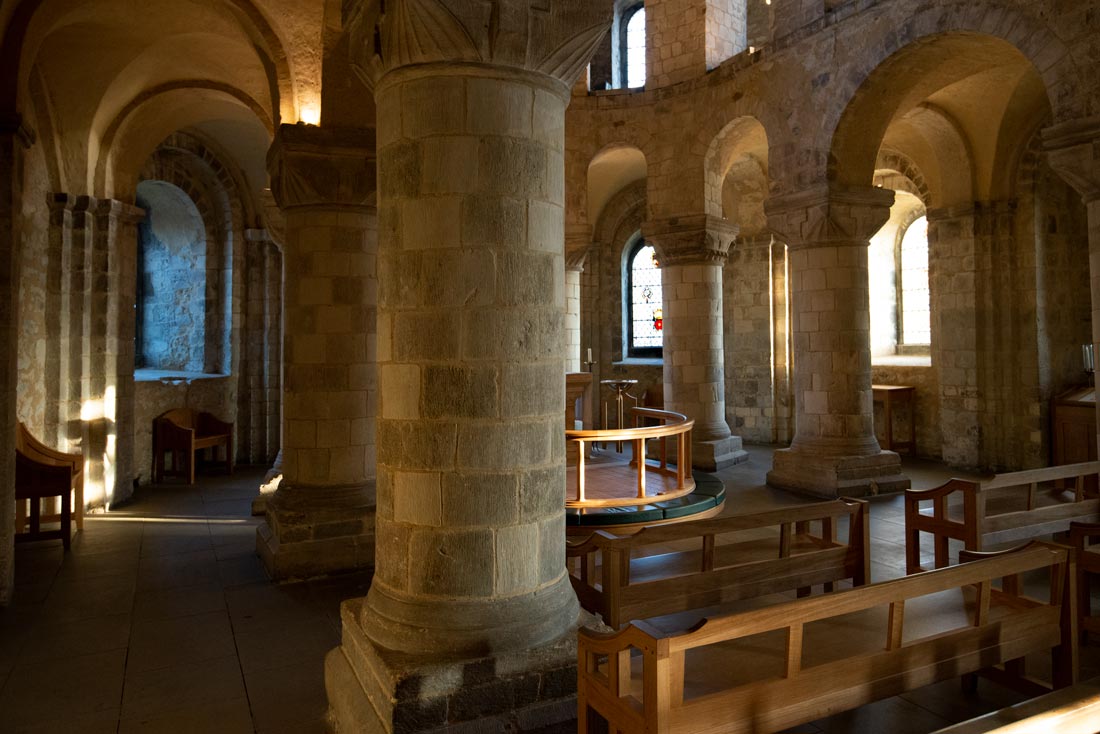
The Norman Chapel of St. John in the White Tower.
A tradition arose for a time of monarchs staying at the castle the night before their coronations and traveling to Westminster Abbey for the coronation in a grand procession. Henry VIII and his wife Catherine of Aragon did so in 1509. By 1530, Catherine had not produced a male heir. Henry divorced her to marry Anne Boleyn, precipitating the British monarchy’s historic break with the Roman Catholic Church and eventually placing the British monarch as the head of the independent Church of England. Anne was crowned queen in an elaborate celebration that included a flotilla of barges with colorful decorations and trumpeters that brought Anne to the tower, where Henry greeted her with a kiss and gun salutes. A procession from the tower to Anne’s coronation at Westminster Abbey and days of pageantry and jousting followed. Anne was pregnant with Henry’s daughter, who grew up to become Queen Elizabeth I (r1558-1603).
Grass now grows over the remains of a magnificent Tudor palace that Henry built at the tower for Anne. The onion domes on top of the White Tower are the castle’s last remaining vestiges of his spending spree for Anne there. The Tower was no longer used as a royal residence after Henry VIII.
Nonetheless, a flock of seven ravens is carefully tended and breeded by a ravenmaster, one of the Yeoman Warders at the castle, as legend holds that the monarchy will fall if the ravens leave. One of each bird’s wings is clipped to prevent it from flying away. Ravens were valued in London long before the castle was built as they cleaned up bones and edible refuse on the streets. Royal decrees have been issued protecting the birds at the castle for hundreds of years.
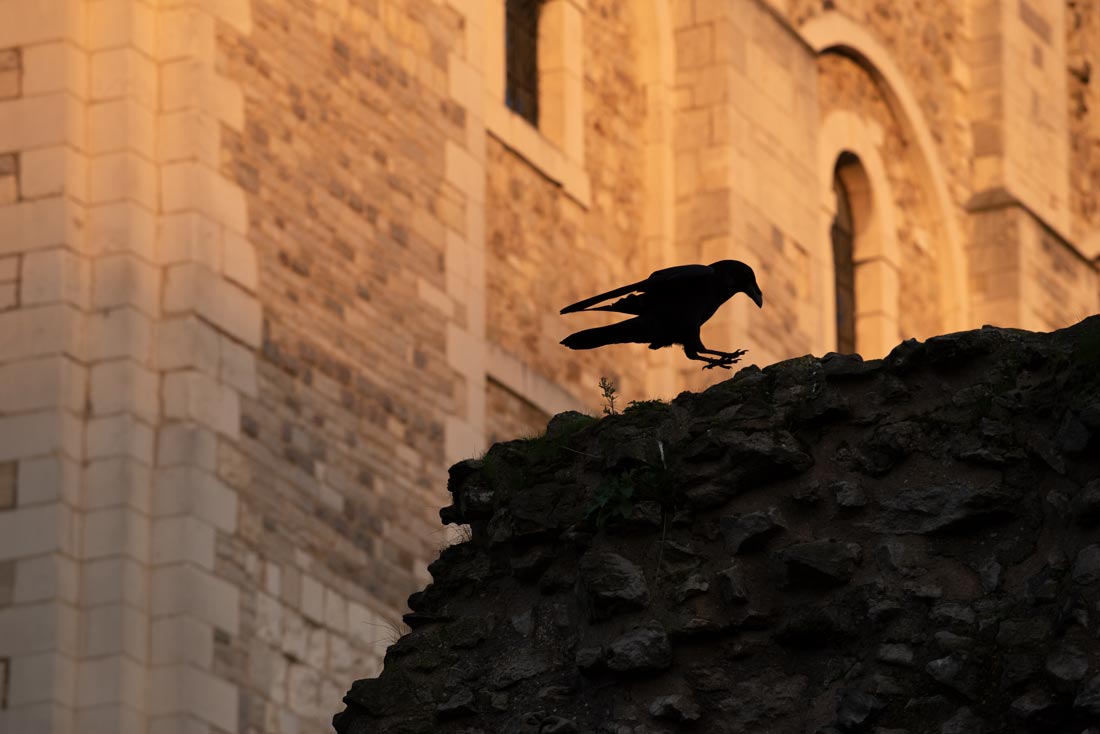
A raven with the White Tower behind it.
The royal astronomer disliked the birds because they left droppings on his telescope. Each raven has a different colored leg band to make it easier to identify them. There have been occasional raven escapes, and one raven had to be retired in 1986 because he interfered with the television aerials there. During World War II, bombing killed all but one of the ravens, but the flock now is carefully bred and tended.
Prison
The tower, the most important royal prison from 1100-1952, is famous for high-profile prisoners being “sent to the Tower,” although that was not its main purpose. The first prisoner held there was Ranulf Flambard, a bishop accused of extortion, in 1100. He escaped down a rope that had been smuggled to him in a barrel of wine.
By the reign of Edward I (1272-1307), the tower was in regular use as a prison. Thousands of people were incarcerated in the tower between 1100 and 1952, when London gangsters Ronald and Reginald Kray were the last. Some prisoners suffered torture and years of deprivation, but others of aristocratic status enjoyed relative luxury, servants and food supplied by their wealthy families. The majority were prisoners of war or were imprisoned for their religious and political views.
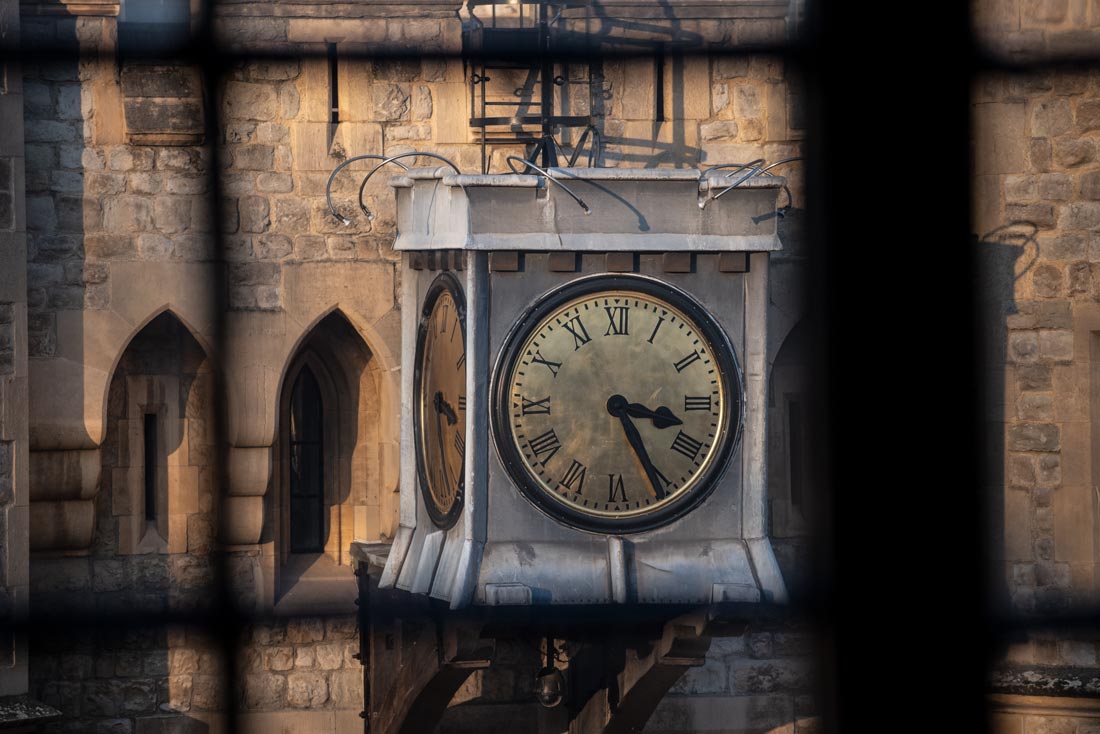
The clock in the Tower of London through bars in a tower window.
A small minority of prisoners were tortured during interrogations. The Privy Council had to sanction the use of torture, so it wasn’t used often. There were 48 recorded uses of torture between 1540 and 1640. The three most common forms of torture were the rack which pulled apart victims' joints, the scavenger's daughter which crushed prisoners’ bones, and manacles by which a victim could be hung up.

The rack at the Tower of London, used for torturing prisoners during interrogations.
William Wallace was housed in the Tower by Edward I and then hung, drawn and quartered for his heroic defiance of Edward in the cause of Scottish independence.
Jesuit priest John Gerard, imprisoned at the tower for his religious beliefs in 1594, wrote later: “Then they put my wrists into iron gauntlets and ordered me to climb two or three wicker steps. My arms were then lifted up and an iron bar was passed through the rings of one gauntlet, then through the staple and rings of the second gauntlet. This done, they fastened the bar with a pin to prevent it slipping and then, removing the wicker steps, they left me hanging by my hands and arms fastened above my head.”
One of those tortured was Guy Fawkes, who confessed after torture to plotting to blow up Parliament in 1605.
Most Tower prisoners sentenced to death were executed on Tower Hill outside the Tower walls. Nobles were beheaded, while commoners were hanged. The site of the scaffold is marked by a memorial in Trinity Gardens at the top of the hill, which lists about 30 noble names. However, about 440 people were killed on or near the site, the majority of whom were Jews in the 1270s.
At Tower Green within the castle, 10 people were executed – seven beheaded and three shot. Three were queens. Anne Boleyn, the second wife of Henry VIII, was executed for adultery, as was Catherine Howard, Henry’s fifth wife, but many historians believe neither was guilty and that Henry disposed of them because they didn’t produce a male heir. In Anne’s case, Henry already had his eye on his next wife, Jane Seymour, and was encouraged to get rid of Anne by powerful advisors with whom Anne had clashed. Anne was arrested and taken by barge to the Tower on May 2, 1536. She was kept at the Tower for two weeks, during which she was tried in the Great Hall, which no longer exists. She was found guilty and executed on a scaffold by an expert French swordsman.
Lady Jane Grey, queen for nine days, was a 16-year-old innocent pawn in a failed military coup by her father-in-law. Her husband Lord Guildford Dudley also was executed there, and she saw his decapitated body from her window an hour before she was beheaded.
A memorial commemorates them and others who were beheaded. Jane Boleyn, Anne Boleyn’s sister-in-law, died with Catherine Howard. Catherine’s lady-in-waiting, Jane was considered complicit in the queen’s alleged adultery. Margaret Pole, a countess of Salisbury, was executed by Henry VIII for her supposed involvement in a Catholic invasion. Robert Devereux, Earl of Essex, was executed on the orders of Elizabeth I. Others were executed for being involved in a mutiny. The three executed queens and three Lords are buried in St. Peter ad Vincula along with Sir Thomas More and John Fisher, who were executed on Tower Hill for their opposition to Henry VIII’s break with the Catholic Church. The two later were made Catholic saints.
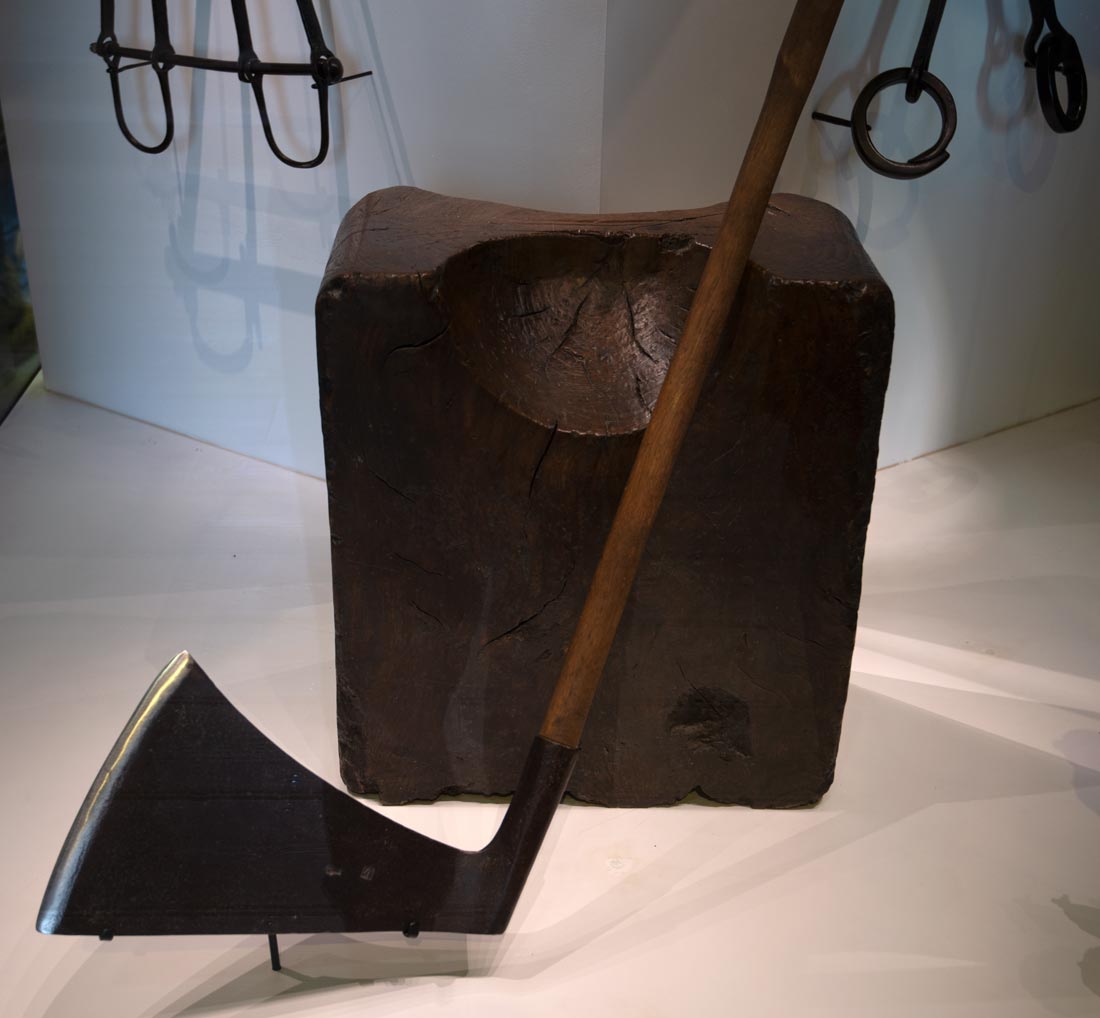
The execution axe and block at the Tower of London.
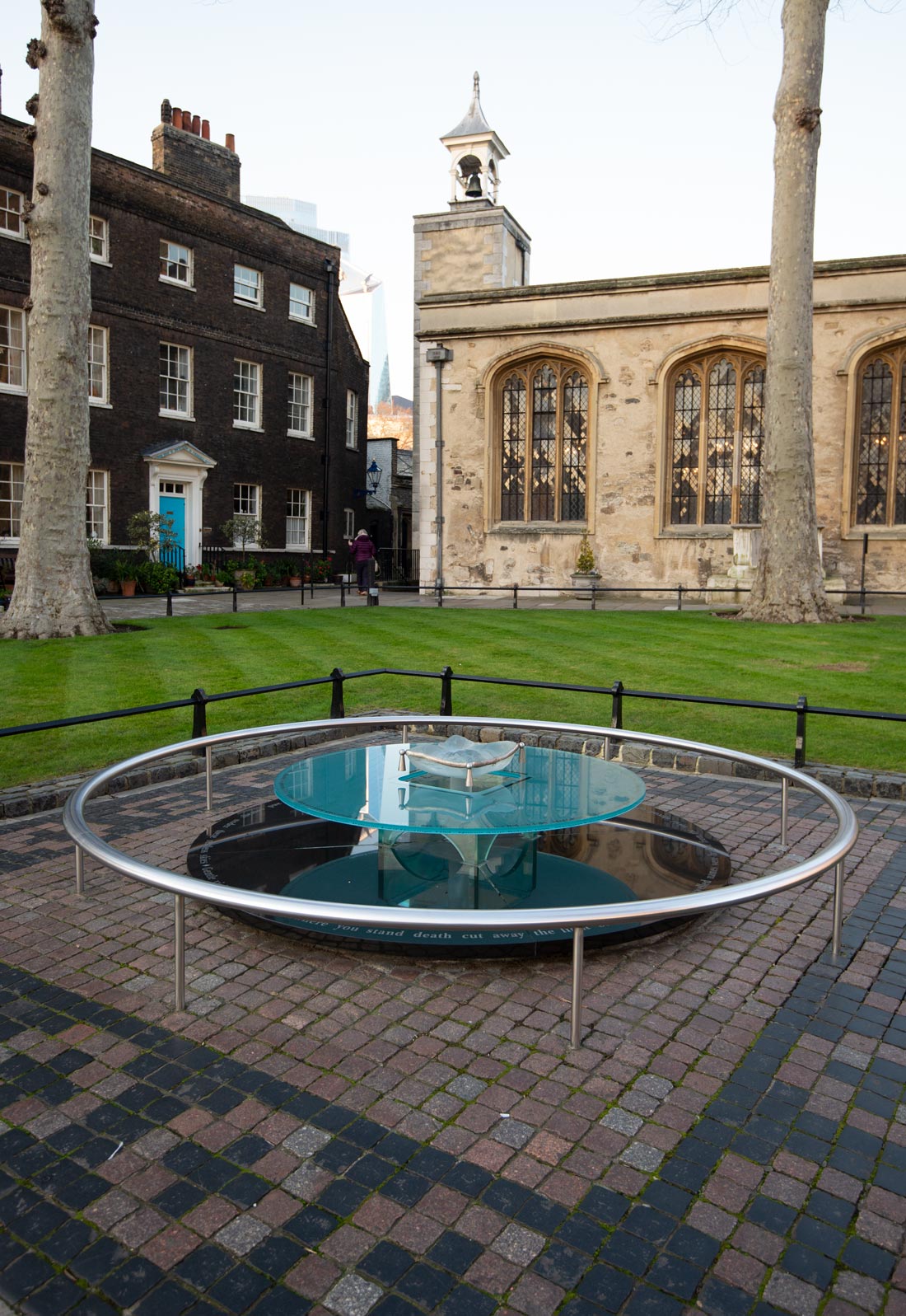
The memorial on Tower Green to those executed there and behind it, the Church of St. Peter ad Vincula, where three beheaded queens and three beheaded lords were enterred.
The Tower was not constructed as a prison – prisoners were kept anywhere. Many prisoners’ only crime was being on the losing side of wars between the dynasties, in which religious beliefs indicated allegiance to the king or a challenger. Henry’s first wife Catherine’s daughter Mary I (1553-8) was Catholic and under her, the country returned to Catholicism. Many of her rivals and key Protestant figures were imprisoned at the tower. Among them were Lady Jane Grey and Princess Elizabeth, who later became queen in 1554. Elizabeth was Protestant, and she continued to use the tower to hold high status and high security prisoners, including Catholics. It was illegal to be a Roman Catholic priest when Elizabeth reigned, and many were arrested and charged with treason. Some went into exile and others were tortured, hanged, drawn and quartered. Some prisoners, mostly in the 16th-17th centuries, left inscriptions carved in the walls of the Salt Tower where they were held. Catholic priest Henry Walpole carved his name into the tower wall.
Among the most famous prisoners in what was called the Bloody Tower was Sir Walter Raleigh. His family could be with him, he had a child born there, he conducted scientific experiments in the tower gardens and he wrote his book History of the World there. He was held at the Tower three times – once for marrying without the queen’s permission, once for plotting against James I (c. 1603-1625) and once for violating a treaty with Spain while looking for El Dorado in South America. He was executed in 1618.
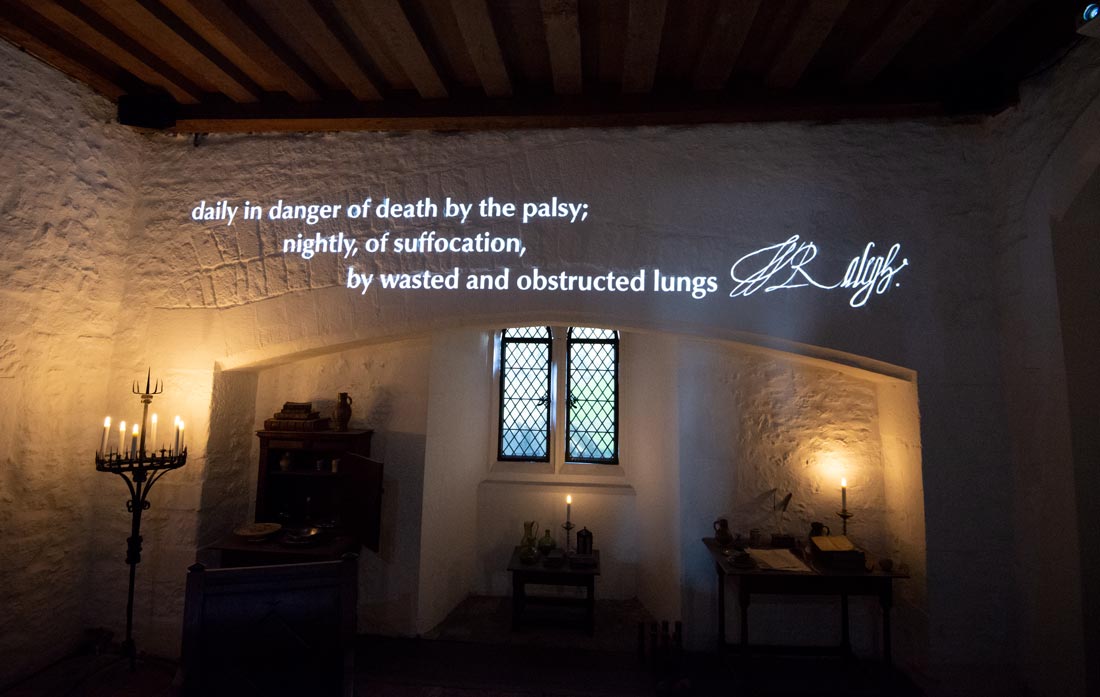
Exhibit showing where Sir Walter Raleigh was imprisoned in the Tower of London before his death.
The tower wasn’t very secure because people could bribe the guards to help them escape. In 1323, Roger Mortimer was aided in escaping from the Tower by the tower’s Sub-Lieutenant who let Mortimer's men inside. They hacked a hole in his cell wall and Mortimer escaped to a waiting boat. He fled to France where he encountered the king’s queen and the two plotted to overthrow the king. Mortimer returned to England in 1326, captured the Tower and released the prisoners held there. He ruled for four years while then-King Edward III was too young to do so. In 1330, Edward and his supporters captured Mortimer and threw him back in the Tower.
Edward IV later imprisoned his treacherous brother, George, Duke of Clarence, Shakespeare's "quicksand of deceit", in the Tower for treason. Clarence had rebelled against Edward. Their mother, Cecily Neville, Duchess of York, asked that her son's execution not be a public spectacle. George was executed secretly in the tower in 1478. He is reported to have been drowned in a wine barrel. Edward later regretted this act.
Several kings of Scotland and France were held at the Tower after being captured in battles, as were several kings of England. In 1399, King Richard II was accused of being a tyrant by his cousin Henry Bolingbroke and forced to renounce his throne while being held in the tower. The next day, Henry became King Henry IV, and it is unclear what happened to Richard. Henry IV himself was killed at the tower in 1471. His two young sons, Edward V and his brother, were taken to the Tower on the orders of their uncle, the duke of Gloucester. They were declared illegitimate and the uncle was crowned King Richard III. After that, the princes disappeared. Rumors of them having been murdered eventually became the inspiration for William Shakespeare’s unflattering portrayal of Richard III. In 1674, more than 200 years later, workers found two skeletons in the staircase leading from the royal apartments to the Chapel of St. John while the staircase was being dismantled. Many people believed they were the boys, although others questioned it because they were found at the level of a Roman graveyard. The bones were reinterred at Westminister Abbey. In 1933, the remains were examined and it was determined that they belonged to two boys about 10-12 years old. The name of the tower they were found in changed to the Bloody Tower because of the association with the princes’ murder. A marble tablet in the Wakefield Tower marks the spot where Henry VI is traditionally said to have met his end. Each year, on the eve of the anniversary of his death, the ceremony of the lilies and the roses is performed, white lilies for Eton College and white roses for King's College, Cambridge are placed there in memory of their founder.
During World War I, the tower was used as a prison and place of execution for spies, with 11 spies held and executed there. The final execution at the tower was in 1941, of German Joseph Jakobs. Hitler’s deputy, Rudolf Hess, also was held there briefly that year. The tower was damaged by bombing in World War II. Vegetables were grown in the moat during the war.
Charles I’s reign (r1625-1649) ended in bloody civil wars between the King and Parliament.The Parliamentarians won control of the tower, a fatal blow to the King’s forces. Parliament arranged Charles’ execution in 1649 and sold his possessions, melting down the silver and gold in the Crown Jewels and selling the jewels. Oliver Cromwell became Lord Protector in 1653 and installed the castle’s first permanent garrison.
Treasure house, records repository and mint
Kings and queens kept their money, valuable clothes, armor, jewels, furniture and food at the Tower of London. It also was used as an archive to store documents of national significance.
The monarchs controlled the production of silver and gold coins in the Tower’s mint for more than 500 years, starting in 1279. Large amounts of precious metals, bullions and coins were stored there. The job of mint warden was once held by Sir Isaac Newton.
Today, the mint is elsewhere, but the Crown Jewels still are displayed in heavily fortified vaults guarded by members of the Regiment of Fusiliers and others who work at the Tower, along with Yeoman Warders. Documents once stored in the Tower were removed in 1858 and now are part of the National Archives in Kew, south London.
Medieval monarchs dressed in silks, furs, gold crowns and jewel-encrusted items, had ornate thrones and lived in elaborately decorated rooms with rich tapestries and golden dishes. Because they traveled frequently, a special department took their clothes, food, jewels, armor and furniture with them. Permanent stores of these items were at the Tower of London and Westminster Palace, but all valuable items were moved to the Tower after a robbery at Westminster in 1303. Only sacred regalia stayed at Westminster Abbey.
Monarchs could pawn their treasure when they needed to raise money and use the treasure to gain independence from the aristocracy.
Since 1994, the Crown Jewels have been on display in the Jewel House in the Waterloo Block of the Tower of London. The queen uses some of the pieces regularly.
Most of the crown jewels are used in the coronation of monarchs. When the monarchy was restored in 1650, Charles II ordered a new set of Crown Jewels. These were added to and modified until Queen Elizabeth II’s coronation in 1953. They include the Sovereign’s Sceptre with Cross, to which was added the magnificent Cullinan I (First Star of Africa) diamond in 1910. It is the largest top quality cut diamond in the world, just over 530 carats. The legendary Kohi-Nur diamond from India is set in the crown of Queen Elizabeth the Queen Mother.
The jewels include a number of crowns and rings, among them one placed on the fourth finger of the monarch’s right hand during the final part of the coronation ceremony. It is the Sovereign’s Ring.
Queen Elizabeth II was crowned with St. Edward’s Crown, made in 1661, and modeled on the first medieval crown of English kings. It is named after King Edward the Confessor (1042-66). After the coronation ceremony, it is traditionally exchanged for the Imperial State Crown, set with some of the most famous diamonds and gemstones. The Queen wears this crown at the annual State Opening of Parliament. The Imperial State Crown contains 2,868 diamonds, 17 sapphires, 11 emeralds, five rubies and 273 pearls, including Elizabeth I’s pearl earrings. Visitors can admire the jewels in the Jewel House while standing on a moving walkway that moves them past the jewels’ glass display cases.
In 1671, Irish soldier Thomas Blood and three companions tied up and gagged Talbot Edwards, Keeper of the Crown Jewels, then stabbed and beat him. They seized crowns, the orb and the sceptre but were caught when the keeper’s son returned home and raised the alarm. King Charles II pardoned Blood.
In 1913, suffragette Leonora Cohen concealed an iron bar under her coat and threw the bar, smashing a case containing the insignia of the Order of Merit which is part of the Crown Jewels. She was protesting treatment of women prisoners. She was arrested, taken to court and released without being charged.

Replica of the 12th-century coronation spoon used to hold holy oil during a monarch's coronation. It and three swords are the only items that survived Oliver Cromwell's rule. For security reasons, the original spoon and other Crown Jewels can be viewed but not photographed.
Tourist site
The tower gradually became obsolete as gunpowder-based siege machines such as cannons were widely adopted. From the 16th century onward, the tower was an armory, barracks and storehouse and a central location where troops could be mustered to head for campaigns in Europe. A Grand Storehouse for weapons and ammunition was built in the late 1600s. The flooring on the top floor of the White Tower collapsed under the weight of 2000 barrels of gunpowder in 1691. In the 19th century, the Tower became a military headquarters with a large garrison.
The moat, which smelled and caused health problems among the garrison, was drained in the 1800s. The Tower has not been used defensively since a revolt over electoral reform in the 1840s. It became a popular tourist site in the 1830s and offices, storerooms, taverns and barracks were moved elsewhere as the castle was restored to a medieval appearance.
The main threat to the tower today is the exhaust of cars on nearby streets turning the White Tower yellow.
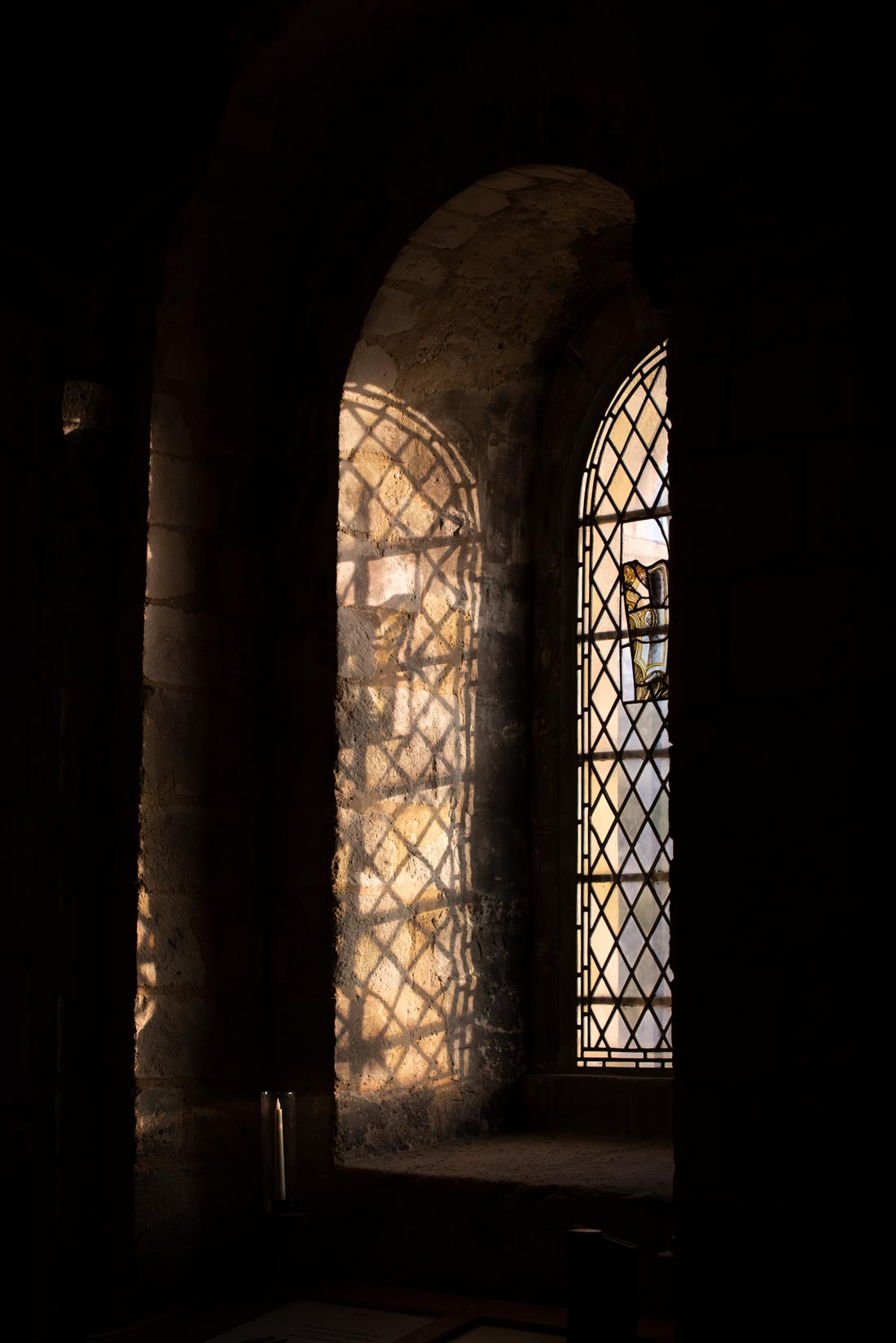
Check out these related items
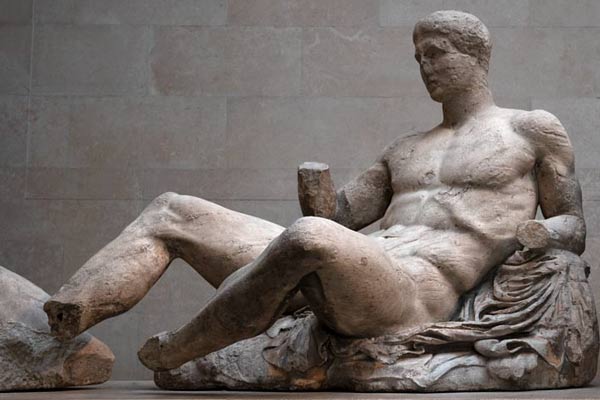
Britain and Greece’s Parthenon Dispute
What are the chances that two men from one family set off international disputes by carting off treasures from Greece and China?
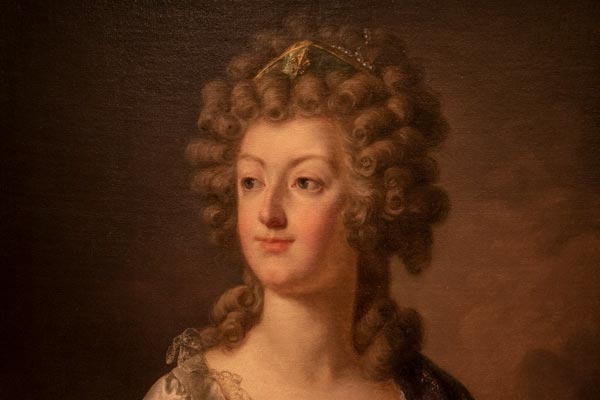
Marie Antoinette and Barbie
Since she was guillotined in the French Revolution, Marie Antoinette has become one of the most popular icons worldwide.
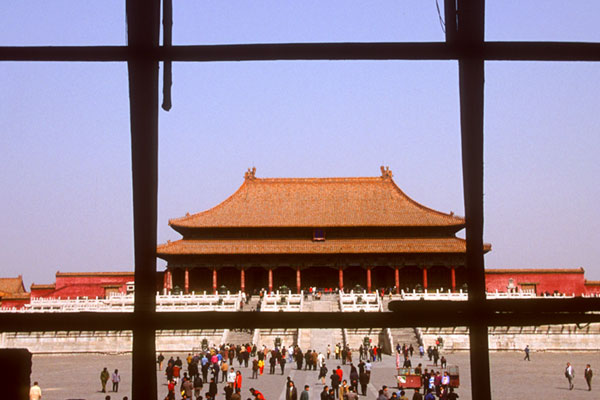
Scaffolding the World
Finding a historical site shrouded in scaffolding is disappointing, but it is a valuable tool for preserving the world's heritage.
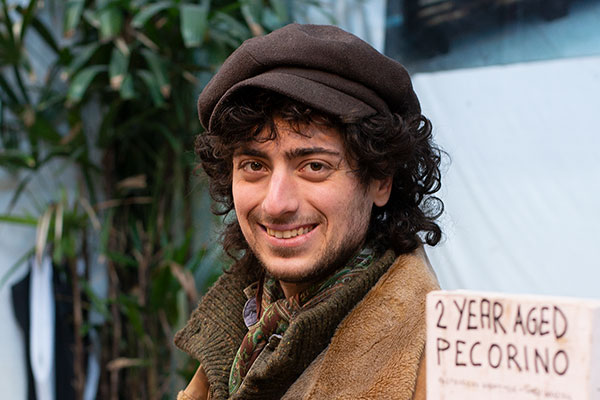
London’s Best Food Market
Borough Market near London Bridge is one of the best foodie spots in London.
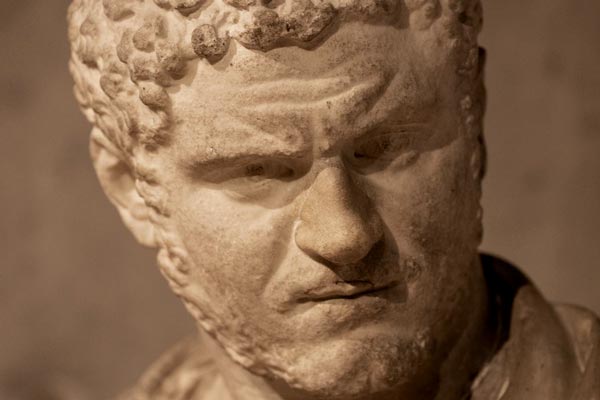
A Tale of Two Roman Cities
The amphitheaters, military garrisons, forums, trade and craft shops of two Roman colonial cities have emerged from the dust.
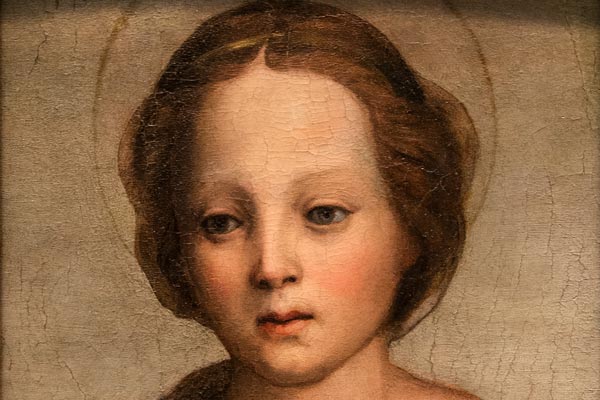
Portraits of Mary
Mary, the mother of Christ, may be the most prominent visual icon in the world. We explore her history.
